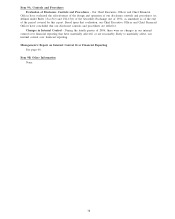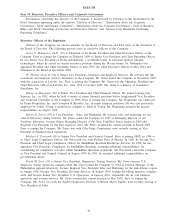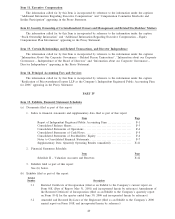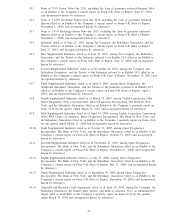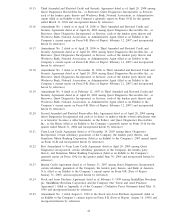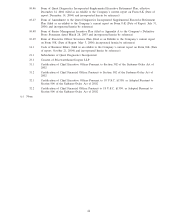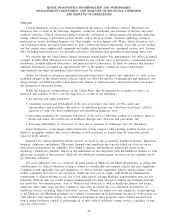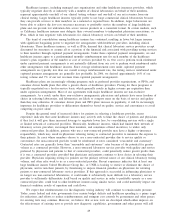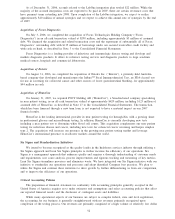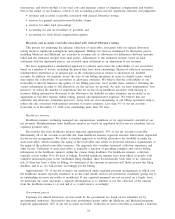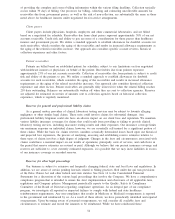Quest Diagnostics 2006 Annual Report Download - page 69
Download and view the complete annual report
Please find page 69 of the 2006 Quest Diagnostics annual report below. You can navigate through the pages in the report by either clicking on the pages listed below, or by using the keyword search tool below to find specific information within the annual report.QUEST DIAGNOSTICS INCORPORATED AND SUBSIDIARIES
MANAGEMENT’S DISCUSSION AND ANALYSIS OF FINANCIAL CONDITION
AND RESULTS OF OPERATIONS
Overview
Clinical laboratory testing is an essential element in the delivery of healthcare services. Physicians use
laboratory tests to assist in the detection, diagnosis, evaluation, monitoring and treatment of diseases and other
medical conditions. Clinical laboratory testing is generally categorized as clinical testing and anatomic pathology
testing. Clinical testing is performed on body fluids, such as blood and urine. Anatomic pathology testing is
performed on tissues, including biopsies, and other samples, such as human cells. Many clinical laboratory tests
are considered routine and can be performed by most commercial clinical laboratories. Tests that are not routine
and that require more sophisticated equipment and highly skilled personnel are considered esoteric tests. Esoteric
tests, including gene-based tests, are generally referred to laboratories that specialize in performing those tests.
We estimate that the United States clinical laboratory testing market had approximately $45 billion in annual
revenues in 2006. Most laboratory tests are performed by one of three types of laboratories: commercial clinical
laboratories; hospital-affiliated laboratories; and physician-office laboratories. In 2006, we estimate that hospital-
affiliated laboratories accounted for approximately 60% of the market, commercial clinical laboratories
approximately one-third and physician-office laboratories the balance.
Orders for laboratory testing are generated from physician offices, hospitals and employers. As such, factors
including changes in the United States economy which can affect the number of unemployed and uninsured, and
design changes in healthcare plans which impact the number of physician office and hospital visits, can impact
the utilization of laboratory testing.
While the diagnostic testing industry in the United States may be impacted by a number of factors, we
believe it will continue to grow over the long term as a result of the following:
•the growing and aging population;
•continuing research and development in the area of genomics (the study of DNA, genes and
chromosomes) and proteomics (the analysis of individual proteins and collections of proteins), which is
expected to yield new, more sophisticated and specialized diagnostic tests;
•increasing recognition by consumers and payers of the value of laboratory testing as a means to improve
health and reduce the overall cost of healthcare through early detection and prevention; and
•increasing affordability of, and access to, tests due to advances in technology and cost efficiencies.
Quest Diagnostics, as the largest clinical laboratory testing company with a leading position in most of its
domestic geographic markets and service offerings, is well positioned to benefit from the long-term growth
expected in the industry.
Payments for clinical laboratory testing services are made by the government, healthcare insurers, physicians,
hospitals, employers and patients. Physicians, hospitals and employers are typically billed on a fee-for-service
basis based on negotiated fee schedules. Fees billed to patients and healthcare insurers are based on the
laboratory’s patient fee schedule, subject to any limitations on fees negotiated with the healthcare insurers or with
physicians on behalf of their patients. Medicare and Medicaid reimbursements are based on fee schedules set by
governmental authorities.
We incur additional costs as a result of our participation in Medicare and Medicaid programs, as billing and
reimbursement for clinical laboratory testing is subject to considerable and complex federal and state regulations.
Compliance with applicable laws and regulations, as well as internal compliance policies and procedures, adds
further complexity and costs to our operations. While the total cost to comply with Medicare administrative
requirements is disproportionate to our cost to bill other payers, average Medicare reimbursement rates are not
materially different than our overall average reimbursement rate from all payers, making this business generally
less profitable. Government payers, such as Medicare and Medicaid, as well as healthcare insurers and larger
employers, have taken steps and may continue to take steps to control the cost, utilization and delivery of
healthcare services, including clinical laboratory services. Despite the added cost and complexity of participating
in the Medicare and Medicaid programs, we continue to participate in such programs because we believe that our
other business may depend, in part, on continued participation in these programs, since certain customers may
want a single laboratory capable of performing all of their clinical laboratory testing services, regardless of who
pays for such services.
48


